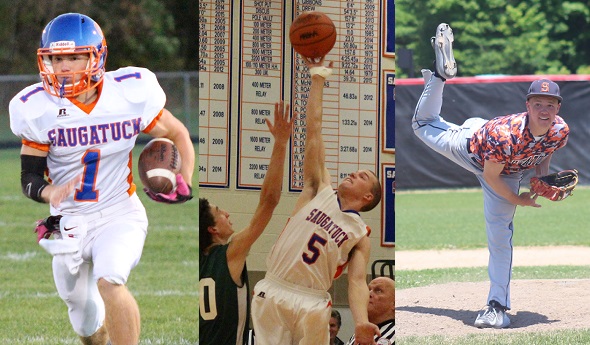
Standout Dunn Does it All for Saugatuck
April 22, 2016
By Dave Sontag
Reprinted from Prep Baseball Report
At times, he wears a uniform under his uniform.
The attire that rests inside his baseball jersey has an “S” on the chest. The “S” should stand for Superman. For Saugatuck multi-athlete Blake Dunn, he doesn’t think playing four varsity sports each school year is newsworthy.
“Personally, I have never wanted to give up on any sports. I have the support from all of the coaches. I never wanted to close the door to any of the sports,” Dunn said.
The talented junior is currently competing on his school’s baseball and track & field teams. He hopes to end his high school career earning 16 varsity letters, an unprecedented feat in Saugatuck history.
Dunn has been the starting quarterback for three years and starred on the basketball court for three winters. In an age when many high school athletes prefer to specialize in one sport, Dunn has a different attitude.
“High school only happens once,” Dunn said. “My parents are behind me and my coaches all support me.”
So how does Dunn prepare for each of his spring sports?
Track coach Rick Bauer allows Dunn to conduct his workouts in the morning – before school. Baseball coach Dave Gawlak then works with Dunn after school on the diamond. Game and meet conflicts are minimal during the spring sports season.
It helps that Saugatuck’s athletic director is Bill Dunn, Blake’s dad. The veteran AD has not scheduled many events when baseball and track are competing on the same day. However, Blake did have to make a decision his freshman year when both the track and baseball teams traveled to Bloomingdale High School on the same day.
Blake said that day at Bloomingdale was the most memorable he has had during his high school career.
“I started off playing baseball that day and singled in my first at bat,” Dunn said. “I then changed into my track uniform and won three straight events.”
Dunn won the 110-meter hurdles, the 300 hurdles and as part of the 800 relay before changing back into his baseball uniform.
With the “S” etched on his chest, how did Dunn cap his full day of competition?
“I went back to the baseball field and hit a home run in my next at bat,” Dunn said.
Dunn not only intends to earn 16 varsity letters in his high school career, he also has earned all-state recognition in all four sports. He’s also recently been added to the MHSAA football record book for his accomplishments this past season.
Which sport does he like the best?
“I love them all so much. I really don’t know which one is my favorite,” Dunn said.
As an elementary student, Blake grew up on the gridiron with his dad, who is also Saugatuck’s football coach. Being a coach’s son, Blake serves as another coach on the field.
“He’s always hung around the field,” Bill Dunn said. “Ever since second or third grade, Blake has been around me on the football field.”
The 5-foot-11, 180-pounder said there is nothing like “the Friday night lights in football and the Friday night crowds in basketball.”
“I have limited opportunities to play sports. I don’t want to miss out on any of them,” Blake Dunn said.
Demonstrating talent on the basketball court, Dunn scored 51 points against Lawton this winter. He finished his junior year with more than 1,000 career points.
Dunn’s offseason schedule consists of playing travel baseball and working out with the school’s basketball and football teams.
“I don’t wear myself out playing one sport and possibly getting hurt,” Dunn said.
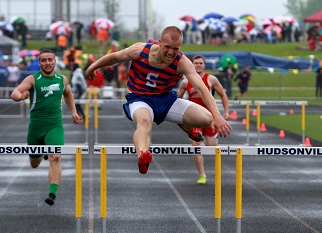 Dunn does realize that college coaches encourage athletes to play multiple sports. In fact, statistics have proven that high school athletes who specialize in one sport are at an increased risk of injuries – especially knee and hip injuries.
Dunn does realize that college coaches encourage athletes to play multiple sports. In fact, statistics have proven that high school athletes who specialize in one sport are at an increased risk of injuries – especially knee and hip injuries.
David Bell, a professor of kinesiology and orthopedics and rehabilitation at University of Wisconsin, said after his school completed its recent study “Prevalence of Sport Specialization in High School Athletics” that parents need to be more cognizant of their children specializing in one sport.
Athletes who trained in one sport for more than eight months during the study were more likely to have a history of knee and hip injuries, Bell reported.
The MHSAA also is currently spearheading a task force to promote multi-sport participation.
“For years it seemed educators were alone in promoting the multi-sport experience as the best for young people,” Executive Director Jack Roberts said. “Major college football coaches, members of the USA Women’s World Cup Soccer championship team, Hall of Fame pitcher John Smoltz, PGA golfer Jordan Spieth and others demonstrate to us that the multi-sport experience is the healthiest and happiest way to participate in youth sports.”
While playing four sports has kept Dunn busy athletically, he has been able to keep his grades solid. He holds a 3.95 grade-point average with a rigorous schedule.
The two-way baseball player has made a verbal commitment to play at Western Michigan University after high school. He is not sure if he will continue at WMU on the mound or as a catcher – or both.
“They have talked to me about maybe catching and then closing on the mound,” Dunn said.
Staying close to home does not surprise his dad.
“He’s really a down-home kid,” Bill Dunn said of his son. “The relationship with Billy (Gernon, WMU’s coach) is awesome.
The elder Dunn is proud of his son’s work ethic.
“He has God-given skills, but he works at it.” Bill said. “I remember him coming off of a basketball game on a Friday night and heading to Kalamazoo the next morning at 6:30 to work out for three hours.”
The talented junior has been clocked pitching at 90 mph and ran a 6.7-second 60-yard dash.
The script for Dunn has been storybook-like. Peeling off one uniform only to compete in another sport, he has carved quite an athletic career.
But while Western Michigan is waiting for the multi-talented athlete to finish high school, Blake will continue doing what he does best – performing at the highest level on his way to 16 varsity letters.
PHOTOS: (Top) Dunn has starred in football, basketball and baseball during the 2016-17 school year. (Middle) Dunn also was a Lower Peninsula Division 4 champion last spring in the 300 hurdles and as part of the 1,600 relay. (Top photos courtesy of the Dunn family, middle photo by RunMichigan.com.)
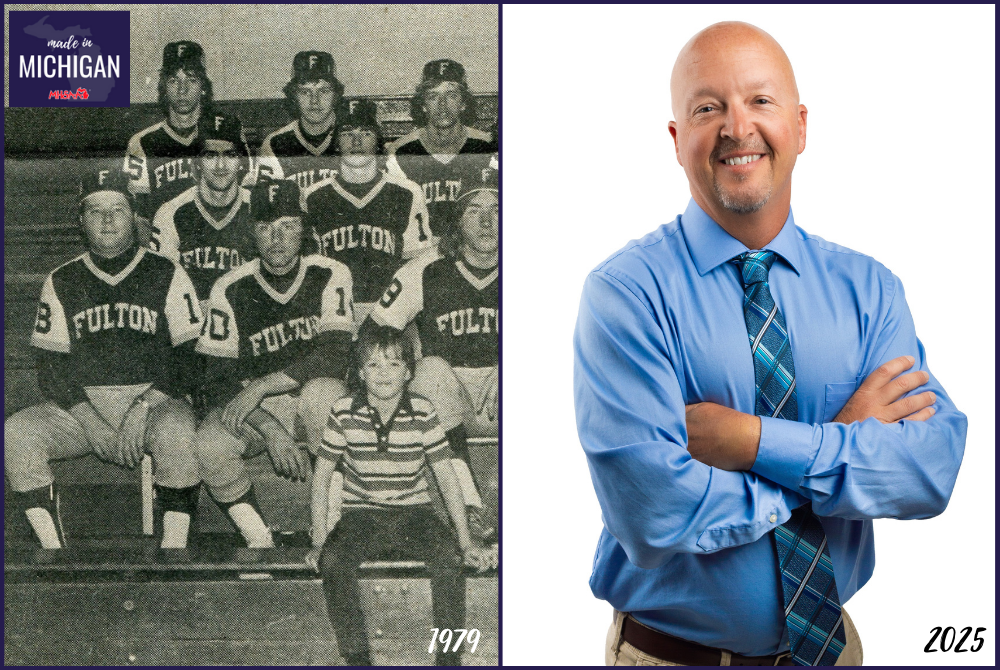
In 'Turn & Burn,' Kent III Gives Voice Again to Father's Life Lessons, Coaching Wisdom
By
Geoff Kimmerly
MHSAA.com senior editor
August 29, 2025
As his son, his player and during their time coaching together, Warren Kent III was front row for the words of wisdom often shared by his father Warren Kent Jr., who coached a multitude of sports at seven schools over more than three decades.
 But as the years have rolled on after his father’s death in 2017, Kent III began to realize something most disheartening – he’d forgotten the sound of his dad’s voice.
But as the years have rolled on after his father’s death in 2017, Kent III began to realize something most disheartening – he’d forgotten the sound of his dad’s voice.
In an attempt to regain that memory, Kent III has given us all an opportunity to listen.
His book – “Turn & Burn” – is the story of a son growing to love baseball under the tutelage of his father, a teacher and coach of the local varsity. The seeds for that love of the game are planted during the summer of 1984 – coinciding with the Detroit Tigers’ most recent World Series championship season.
Technically, the story is fiction. But it’s set in Fulton Township, which lies just west of US-127 between St. Johns and Ithaca, where Kent Jr. was indeed a coach and Kent III grew up and attended Fulton High School. And all of the information on the Tigers’ historic run that season – including game-by-game synopses of all 162 plus eight in the playoffs – is true as well and easily will connect with fans who, like Kent III, grew up during that unforgettable summer.
“That was my thing. I wanted people to get the feelings I had with the ’84 Tigers and sharing that with my dad as I was growing up,” he said. “My outlet is writing, so this is really a catharsis, just to get this out there, to let other people know the love of the Tigers but more the love of my father and things we went through together.”
Kent III was five months old when the Tigers won their 1968 World Series championship, but 16 in 1984. He said his book is about 70 percent factual, but even the imagined is rooted in reality.
The main character in “Turn & Burn” – EJ – is 12 years old because that seemed a more reasonable age to fall in love with the sport, and by 16 Kent III was well into his baseball fandom. The father in the book is a teacher and coach. Kent Jr. was a special education teacher for more than four decades and his son’s baseball coach at Fulton High School but just for freshman year before moving into the stands for the remainder of Kent III’s four-year varsity career.
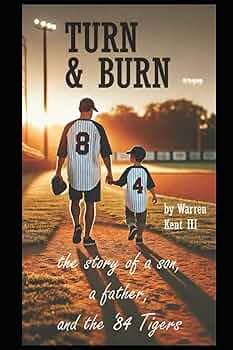 Kent III began coaching baseball himself when he was 18 and served as North Muskegon’s varsity coach for 15 years, including 11 with Kent Jr. as his assistant. At one point in “Turn & Burn” players write EJ’s dad’s initials on their hands because he had been hospitalized after a heart attack; North Muskegon players did the same when Kent Jr. had a heart attack prior to a Pre-District game in 2005.
Kent III began coaching baseball himself when he was 18 and served as North Muskegon’s varsity coach for 15 years, including 11 with Kent Jr. as his assistant. At one point in “Turn & Burn” players write EJ’s dad’s initials on their hands because he had been hospitalized after a heart attack; North Muskegon players did the same when Kent Jr. had a heart attack prior to a Pre-District game in 2005.
“Some of it’s been changed. Some of it’s been realistic,” Kent III said. “(But the dad) is definitely my dad’s voice.
“I put him in charge of the outfielders at North Muskegon, and that was his one motto – ‘Turn and burn.’ The kids could probably tell you that over and over, (that’s) the one thing Coach Kent would always say.”
A source of many of the fatherly pearls of wisdom found in “Turn & Burn” came from a journal-style “father’s legacy” book Kent III had purchased for his dad years before and asked him to fill out. Kent Jr. passed those on not only to his children but during a coaching run that took him to Hudsonville, Ashley, Fulton, Vestaburg, Blanchard Montabella and Greenville, where notably he led the football program to its first playoff appearance in 2000.
Writing has long been a love for Kent III, who taught English and journalism for 32 years – and served as a yearbook advisor for three decades – while at Battle Creek Central and then the final 27 years at Muskegon Mona Shores. Prior to becoming a teacher, Kent III was “Journalist of the Year” at Ferris State while sports editor of the student newspaper and then moved on to study and serve as sports editor of the paper at Michigan State.
He has written for the Big Rapids Pioneer, Lansing State Journal and Battle Creek Enquirer, among others over the years, and after retiring from teaching at Mona Shores this spring took a position with Walsworth Yearbooks helping schools all over the state with their yearbook programs.
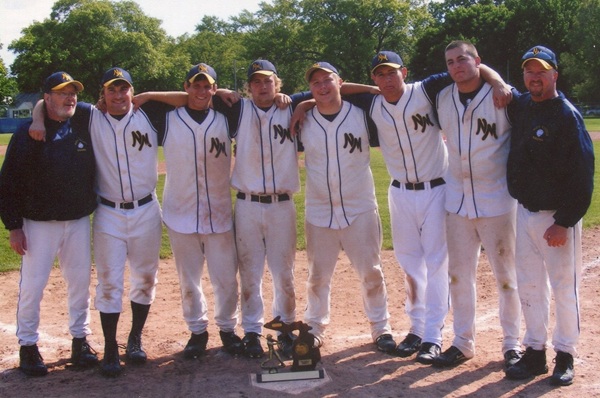 Kent III also is in his 34th year as an MHSAA registered official. He wrote a piece once for Referee Magazine about his experience officiating the 2011 Class D Girls Basketball Final at Breslin Center, home of his beloved Spartans. He’s more recently officiated Basketball Semifinals at Breslin during the 2023 and 2024 seasons and has returned to the baseball diamond as an umpire as well after umping baseball and softball earlier in his career.
Kent III also is in his 34th year as an MHSAA registered official. He wrote a piece once for Referee Magazine about his experience officiating the 2011 Class D Girls Basketball Final at Breslin Center, home of his beloved Spartans. He’s more recently officiated Basketball Semifinals at Breslin during the 2023 and 2024 seasons and has returned to the baseball diamond as an umpire as well after umping baseball and softball earlier in his career.
Writing a book came to Kent III during the COVID-19 pandemic, as he like many searched for something to occupy spare time. “Turn & Burn” is available exclusively via Amazon; click for details.
The venture was never about making money, but he’s sold 152 books – well above his goal of 100. And while Kent III still has not come across any recordings or voicemails of his father’s voice, “Turn & Burn” has given him a chance to hear Kent Jr.’s words once again.
“The sound, no. But the things and the ways he would say them, yes,” Kent III said. “Everybody else says they can picture his voice. I think it’s because, I’m assuming being his son, my voice probably sounds familiar to his to other people, but I can hear the things he’s saying. And in that book, the way he’s saying them.”
2025 Made In Michigan
Aug. 5: After Answering Call, MCC's Caughey Finds Football Lessons Pay Off in Priesthood - Report
July 31: After Enjoying Pro Golf Stardom, Flynn Relishing Roles as Instructor, Sports Mom - Report
July 29: Marckel Supplies Marketing Magic to Hunter's Heisman-Winning Campaign - Report
July 28: Union City to Omaha: Skirka Takes Murray State Baseball to 1st College World Series - Report
July 22: TC West's Wheelock Still 'Living My Dreams' as CMU Assistant Soccer Coach - Report
July 17: Stevenson's Travels Following Lake Orion Success Include Space Force, Penn, NYC - Report
July 15: 'Who Will Cheer for the Nimrods?' Peterson IV, Watersmeet Found Fans Worldwide - Report
July 10: Feeding 'Drive to Win,' Loy Norrix Grad Morgan Impresses with Strong USBC Showing - Report
July 9: After Blazing Multiple Volleyball Trails, Bastianelli Charting Next Career Path - Report
PHOTOS (Top) At left, Warren Kent III sits in the front row of a team photo as manager for dad Warren Kent Jr.'s 1979 Fulton baseball team; Kent Jr. is sitting far left of second row from bottom. At right, Kent III today. (Middle) "Turn & Burn" is Kent III's first published book. (Below) The Kents anchor a photo with North Muskegon players and their District championship trophy in 2009. (Photos provided by Warren Kent III.)

